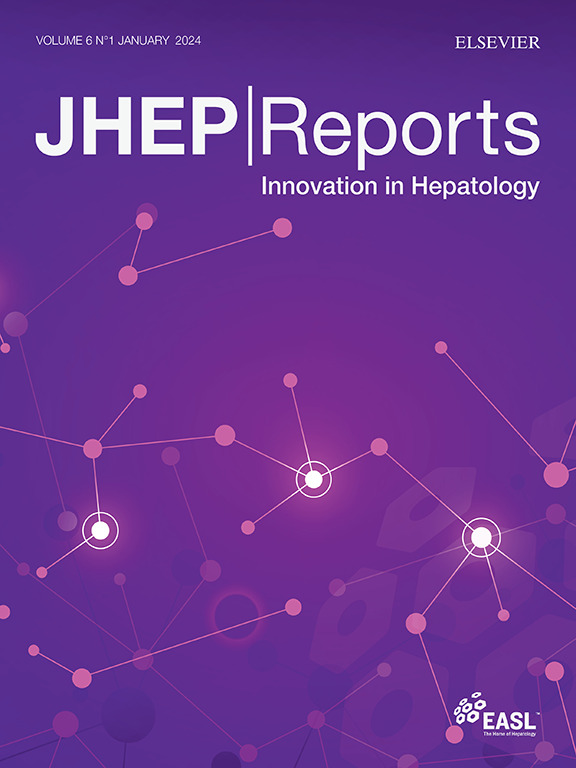奥维西坦治疗进行性家族性肝内胆汁淤积症儿童的实际经验
IF 7.5
1区 医学
Q1 GASTROENTEROLOGY & HEPATOLOGY
引用次数: 0
摘要
背景,先前发表的一项试验表明,odevixibat可有效治疗进行性家族性肝内胆汁淤积症(PFIC)患儿的胆汁淤积性瘙痒。真实世界的经验是必要的,以确认与选择性资格标准注册试验的结果。我们在不同PFIC亚型患者中展示了我们的“现实经验”,即奥维西巴的有效性和安全性。方法采用多中心前瞻性研究,对奥维西巴(40或递增至120 μg/kg/d)治疗的PFIC患者进行研究。瘙痒症在基线和每月至6个月时通过“医生整体症状印象”进行评估。血清胆汁酸(sBA)应答者是在6个月后sBA水平较基线降低≥70%(或值为70 μmol/L)的患者;瘙痒反应者是报告瘙痒评分改善的患者。结果共纳入24例患者,中位年龄6.6岁[3.7-12.1],男:女= 11/13;16例(67%)为典型PFIC类型(PFIC- 1,2;PFIC-2 11;pfic - 3,3),而8例(33%)有罕见的形式(pfic - 4,5, pfic - 5,1;PFIC-6, 1;pfic - 9,1)。所有患者均有高sBA水平,22/24(92%)有瘙痒。4例(17%)有相关的合并症。治疗6个月后,sBA从中位数317.1 μmol/L(范围82.3 ~ 369.0 μmol/L)降至45.6 μmol/L(范围7.2 ~ 120 μmol/L);p & lt; 0.001);瘙痒评分的平均变化为-1.7。总的来说,75%的患者对sBA有反应,73%的患者对瘙痒有反应,30%的患者需要增加剂量。瘙痒减轻与sBA降低显著相关(p <0.05)。截断值为sBA >;333.5 μmol/L, odevixibat无应答的风险增加17倍(p <0.001)。无严重不良事件记录。结论索维西坦对典型PFIC患者和其他罕见亚型患者在现实生活中降低sBA水平和改善瘙痒是有效和安全的。一些患者需要增加剂量以改善对治疗的反应。影响和影响:缺乏关于odevixibat在实际场景中使用的公开数据。我们在诊断为PFIC的儿童(包括典型PFIC和罕见PFIC类型的患者,以及晚期肝脏疾病和相关合并症的患者)的异质队列中探讨了odevixibat的有效性。我们的研究结果表明,在现实生活中,odevixibat对不同PFIC亚型儿童的胆汁淤积和瘙痒是有效的。这些结果支持在患有任何类型pfic的儿童中使用奥维西他,包括那些患有不同阶段肝脏疾病和合并症的儿童。本文章由计算机程序翻译,如有差异,请以英文原文为准。

Real-world experience with odevixibat in children with progressive familial intrahepatic cholestasis
Background & aims
A previously published trial demonstrated that odevixibat is effective in the treatment of cholestatic pruritus of children with progressive familial intrahepatic cholestasis (PFIC). Real-world experience is necessary to confirm the results of registration trials with selective eligibility criteria. We present our ‘real-life experience’ of the effectiveness and safety of odevixibat in patients with different PFIC subtypes.
Methods
We carried out a multicenter prospective study of patients with PFIC treated with odevixibat (40 or escalated to 120 μg/kg/day). Pruritus was assessed by ‘Physician Global Impression of Symptom’ at baseline and monthly up to 6 months. Serum bile acids (sBA) responders were patients who achieved a reduction in sBA levels ≥70% from baseline (or a value <70 μmol/L) after 6 months; pruritus responders were patients who reported improvement in their pruritus score.
Results
In total, 24 patients (median age 6.6 years [3.7–12.1], male:female = 11/13) were enrolled; 16 (67%) had classic PFIC types (PFIC-1, 2; PFIC-2, 11; and PFIC-3, 3), whereas eight (33%) had rarer forms (PFIC-4, 5, PFIC-5, 1; PFIC-6, 1; and PFIC-9, 1). All had high sBA levels and 22/24 (92%) had pruritus. Four (17%) had associated comorbidities.
After 6 months of treatment, sBA decreased from a median of 317.1 μmol/L (range 82.3–369.0 μmol/L) to 45.6 μmol/L (range 7.2–120 μmol/L; p <0.001); the mean change in pruritus score was -1.7. Overall, 75% of patients were sBA responders, 73% were pruritus responders, and 30% required dose escalation. Reduced pruritus correlated significantly with reduced sBA (p <0.05). A cut-off value of sBA >333.5 μmol/L increased the risk of no response to odevixibat by 17-fold (p <0.001). No serious adverse events were recorded.
Conclusions
Odevixibat is effective and safe in reducing sBA levels and improving pruritus in a real-life scenario in both patients with classic PFIC types and in those with other rarer subtypes. Dose escalation is required in some patients to improve the response to treatment.
Impact and implications:
Published data on the use of odevixibat in a real-world scenario are lacking. We explored the effectiveness of odevixibat in a heterogenous cohort of children diagnosed with PFIC (including patients with classic as well as rarer types of PFIC, and with advanced liver disease and associated comorbidities). Our results demonstrate that odevixibat is effective for the treatment of cholestasis and pruritus in children with different PFIC subtypes in a real-life scenario. These results support the use of odevixibat in children with any type of PFICs, including those with different stages of liver disease and comorbidities.
求助全文
通过发布文献求助,成功后即可免费获取论文全文。
去求助
来源期刊

JHEP Reports
GASTROENTEROLOGY & HEPATOLOGY-
CiteScore
12.40
自引率
2.40%
发文量
161
审稿时长
36 days
期刊介绍:
JHEP Reports is an open access journal that is affiliated with the European Association for the Study of the Liver (EASL). It serves as a companion journal to the highly respected Journal of Hepatology.
The primary objective of JHEP Reports is to publish original papers and reviews that contribute to the advancement of knowledge in the field of liver diseases. The journal covers a wide range of topics, including basic, translational, and clinical research. It also focuses on global issues in hepatology, with particular emphasis on areas such as clinical trials, novel diagnostics, precision medicine and therapeutics, cancer research, cellular and molecular studies, artificial intelligence, microbiome research, epidemiology, and cutting-edge technologies.
In summary, JHEP Reports is dedicated to promoting scientific discoveries and innovations in liver diseases through the publication of high-quality research papers and reviews covering various aspects of hepatology.
 求助内容:
求助内容: 应助结果提醒方式:
应助结果提醒方式:


